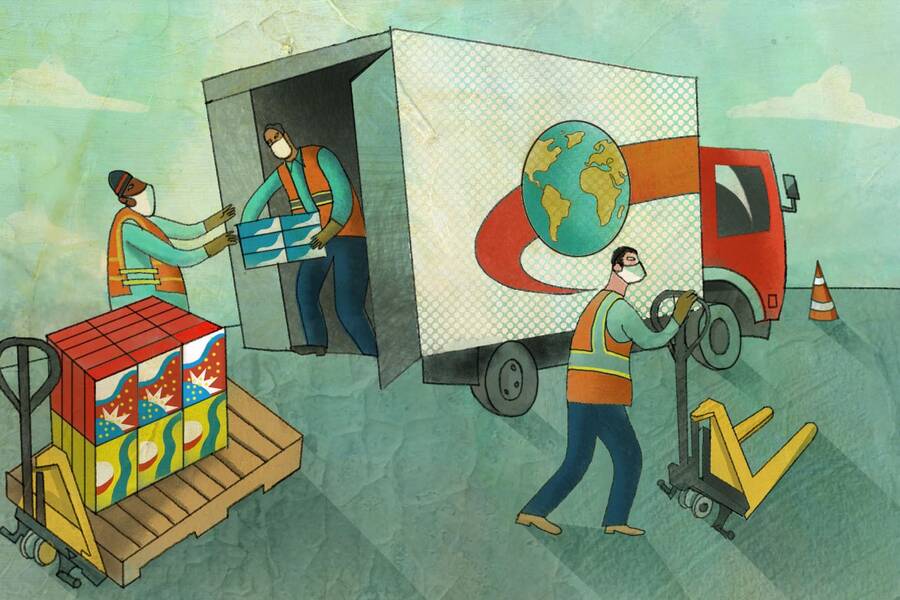Organizations Entrepreneurship Leadership Aug 2, 2021
How One Startup Is Approaching Its Return to the Office
Employees have moved out of state. Job responsibilities have changed. Bringing teams back will be complicated.

Lisa Röper
Andee Harris took over as CEO of the sales coaching and training startup Challenger, Inc. in January, 2021—and still has yet to meet the majority of her new team in person. Oh, and that new team? During the pandemic, about 40 percent of them moved away.
Harris, an adjunct lecturer of innovation and entrepreneurship at Kellogg who has more than two decades’ experience leading young technology companies through rapid-growth stages, knew that taking over a company during the pandemic would be tricky. But finding a new way of working as the nation, and many offices, reopen is proving more challenging than expected.
So what will reentry look like at Challenger, and what can other companies facing similar challenges learn from Harris’s experience? Harris spoke with Kellogg Insight to share one startup’s road back to the office.
This interview has been edited for length and clarity.
INSIGHT: So what does reentry look like at Challenger?
HARRIS: We have about 200 employees in the U.S., mostly based at our headquarter office in D.C., and about 100 internationally, mostly in the UK.
The biggest surprise is that about 40 percent of our workforce moved during COVID. That really snuck up on us: individual managers knew, but there was no one at our organization gathering all that information.
Our workforce spans a wide age demographic. A lot of our younger employees moved back home just to save money. The D.C. area is fairly expensive, so a lot of them felt like why pay rent if they’re just going to be holed up in little apartments? Then a lot of our 30-somethings, many of whom have young families, also moved to save money. They bought or rented homes in cheaper areas because they didn’t have to be so close to the office. A lot of them have now resettled.
And then we had a whole group of employees who took it as an opportunity to live somewhere that they’ve always wanted to live. They moved to Colorado and California during the pandemic, and now want to stay.
Now we’re trying to figure out how to wrangle the team, what the new normal looks like, and how to get people energized to be back at work.
This includes simple, tactical things like how we file unemployment in the different states where people live now. But now we also have to think about company culture. All of a sudden, a lot of members of our team have become remote workers. Do we let them stay remote?
INSIGHT: This seems to be a big question in the tech industry. What steps are you taking to determine whom to bring back?
HARRIS: I hired a chief people officer because I knew this transition back was going to be really hard. We did have an HR generalist and a recruiter, but I felt like we really needed someone to focus on our people and culture.
So we’re working with our chief people officer to figure out how we can transition collaboratively. Our policy is to have team members and their managers figure out if their jobs can be remote based on the parameters and expectations around the job.
For some of our employees, it’s okay. But for others, it’s not. To give you an example, our inside sales reps feed off of the energy of the office—you don’t really want people making cold calls in the basement by themselves. But for our senior consultants, who are typically working with remote clients anyway, it’s not as big of a deal.
The biggest surprise is that about 40 percent of our workforce moved during COVID.
— Andee Harris
But we’re trying to be as sensitive as possible and slow roll into the return to work. Even for the people who are still in the D.C. area, the idea of coming back to the office five days a week is not landing very well—understandably. In these 12-plus months, people have adopted new behaviors.
INSIGHT: How do you get people to want to return, whether for five days a week or even just a few? And is that return picture complicated by your status as a startup?
HARRIS: It’s harder when you have a startup. The difference between a startup and a more mature company is a more mature company may still be growing, but they’re growing at a much slower pace.
When you’re trying to move really fast to scale a startup, it’s a lot easier to have people right there, because you don’t have a lot of the infrastructure and processes that a big company has in place. That gives you flexibility, but it makes a question like bringing a workforce back more complicated.
INSIGHT: Do you feel like the answer is to bolster the infrastructure or to retain the flexibility? Or is it somewhere in between?
HARRIS: I think it’s a combination of both. We are trying to be flexible, but not at a harm to our business. If we feel like someone being remote is a detriment to the business, or it doesn’t make sense based on their job and their role, then we are trying to either transfer them to different departments or different roles—or transition them out.
Luckily our business model changed enough that we can still retain some of those employees even though they moved. We re-platformed our entire training system, so now people can swipe a credit card and do virtual training sessions. Before, training was pretty inaccessible unless you worked for a large company that had a pretty significant sales-training budget. This has enabled a lot of smaller businesses to access our training and coaching and allowed us to scale.
This has allowed us to switch some jobs that were always in-person to be remote.
Incidentally, we can now get talent all over the country, which is a change. We would typically not recruit outside of D.C., Chicago, and the UK. It’s great that we have a much bigger talent pool. I think a lot of companies are excited about that opportunity.
But now we don’t want to just mandate that everyone come back to the office. Instead, we have to decide what to do with this huge office in D.C. Do we need that office space? Does it make sense? We had a satellite office in Chicago, and we let the lease lapse during COVID.
We are trying to figure out: What does our new office space look like, and what do we need it to do? We are thinking about creative solutions to bring people together that don’t necessarily involve them physically working together.
INSIGHT: You’re really asking a fundamental question, which is: What’s the function of socialization within the organization, and how can that be achieved in ways that are not necessarily the same as they have been in the past?
HARRIS: Companies and leaders have to look at it differently. I still think it’s important that teams are together, and that there is bonding and collaboration. I still think that most conflict in the workplace could be resolved through better communication.
I was brought on as CEO at Challenger during COVID, so I have been remote the entire time. I met my leadership team, but I haven’t met most of the people I work with. I’m still a little bit of a stranger to them. If this were a normal time, I would’ve met the entire team by now, and would’ve had lunches and drinks with them, and gotten to know how many kids they have, and what they like to do for fun.
I can pick up on people’s energy when I’m in person with them. Over Zoom, it’s harder. And so, I can often say like, “Hey, it looks like you’re having a rough day. Are you feeling okay?” And as a CEO, it’s really important to be able to tune into that.
I think that it’s important that we get back together. I don’t think anything replaces that human connection. But I’m not advocating that people need to be in the office five days a week.
INSIGHT: You lead a company that trains other companies, which might give you a particularly interesting perspective on this question: How do you see other companies responding to the challenges of bringing people together without them physically being together?
HARRIS: Not surprisingly, we’ve seen other companies as well as ours invest heavily in technology and people to fill this gap, things like paying for employees to get better internet and investing in Zoom and Microsoft Teams.
Intra-office relationships drive competition, obligation to the team, and a sense of urgency to succeed. We have found that these bonds—made through team lunches, happy hours, and “watercooler” chats—improve employee retention and overall engagement, especially for young salespeople. Over the past year and a half, companies have needed to restore that engagement through other means. Virtual happy hours are great, but companies realized it would take much more to build a fair and motivating environment. Some made major changes to compensation plans to improve extrinsic motivation. Some changed their hiring strategies and assessed future employees on different behavioral traits than in the past, such as proof of their ability to work autonomously and stay self-motivated. Managers needed to increase their overall communication and the quality of their coaching and training sessions.
As important as that internal shift has been, a larger challenge for companies was in how they managed their interactions with external clients. Think about an account manager who used to go on-site with a customer for days or even weeks at a time. Yes, they would spend most of that time on project work, but much of that time was spent on relationship-building activities. Suddenly, an eight-hour project day was cut down to four—and then divided into 30-minute Zoom sessions to accomplish specific tasks relating to that project. Sellers who had relied heavily on relationship-based selling suffered immensely. So companies are reevaluating how they train sellers to sell and consultants to consult. As customer conversations changed, client-facing employees needed to change, too.
INSIGHT: Any final thoughts about reentry?
HARRIS: We are really focusing on appreciation of our employees—just really going above and beyond to let our employees know that we care. We’ve launched a lot of initiatives around that.
Leaders and companies are going to have to be very empathetic as people transition out of this. There are going to be a lot of lasting effects of COVID, whether it’s people with long-hauler syndrome, people who lost loved ones, lost jobs. As companies, we need to be supportive of our employees’ mental health.



